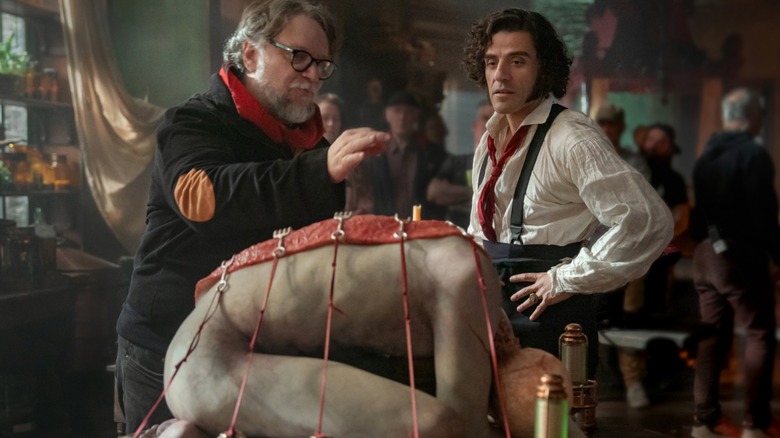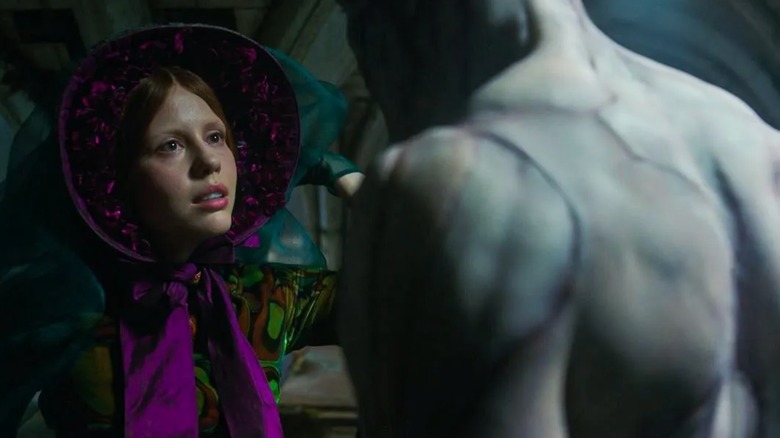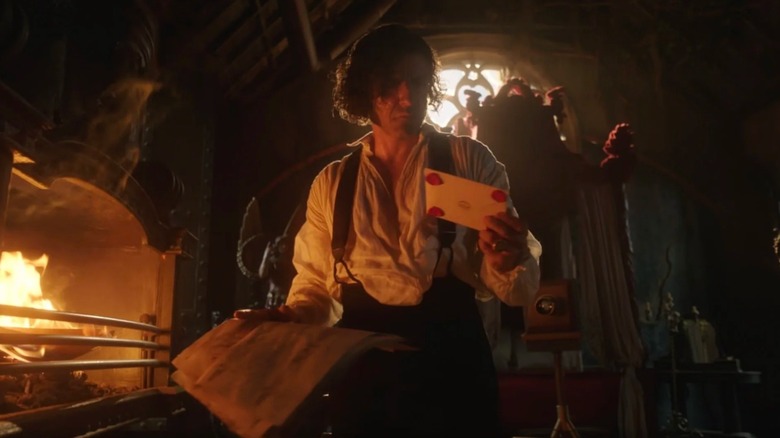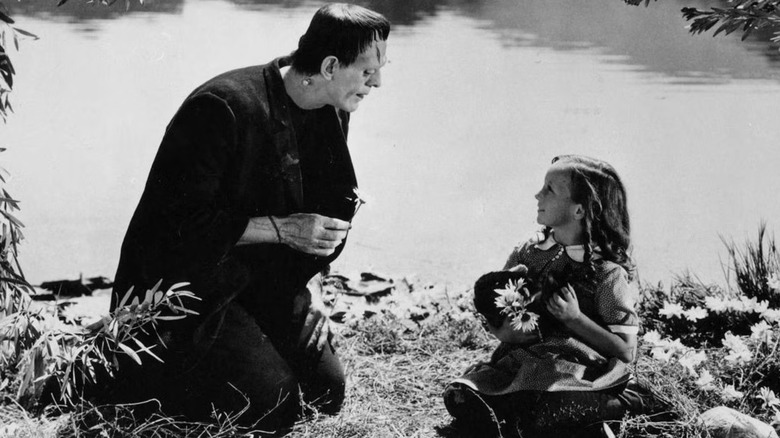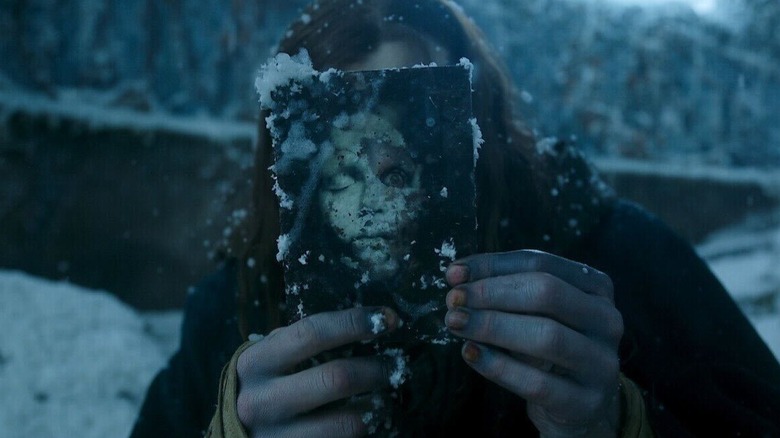Frankenstein: Every Major Way Guillermo Del Toro Changes The Book (For The Better)
We may receive a commission on purchases made from links.
Spoilers for "Frankenstein" follow.
Readers of Mary Shelley's "Frankenstein; or, The Modern Prometheus" know the pop culture image of Frankenstein and his Monster is not especially faithful to Shelley's novel. The Creature, as played by Boris Karloff in Frank Whale's famous 1931 film adaptation, was growling, slow, and childlike, not the eloquent tragic villain who Shelley wrote.
When Guillermo del Toro's "Frankenstein" was announced in 2023, I expected a close adaptation of the novel. After all, del Toro is a devotee of Shelley, and how could he resist the temptation to finally adapt "Frankenstein" correctly? I was right and wrong. Guillermo del Toro's "Frankenstein" has the novel's broad structure, but the details within that outline are rearranged. Some characters or story beats are cut away, while others are added or reframed.
Take how the movie uses the framing device, which many other films excise, where Victor (Oscar Isaac) is hunting his creation (Jacob Elordi) through the Arctic. Frozen and near death, Victor tells his tale to an ambitious sea captain explorer, called Robert Walton in the novel and Anderson in the film, where he's played by Lars Mikkelsen.
In the novel, the Creature tells his post-abandonment woes to Victor, which Victor then recounts to Walton; a story within a story. The film instead has the Creature take over as narrator of this framing device halfway through, splitting itself between "Victor's Tale" and then "The Creature's Tale." It's a corrective change giving the Creature's story and emotions equal weight as his creator's.
Rather than these changes leaving me annoyed by another "unfaithful" adaptation, they made me like del Toro's "Frankenstein" more. I find Kenneth Branagh's 1994 film "Mary Shelley's Frankenstein" a bore because it (largely) just recreates the novel. This "Frankenstein" feels, well, alive with creativity and passion.
Guillermo del Toro remakes Frankenstein all his own
To be clear: I don't think the changes make del Toro's "Frankenstein" superior to the novel, but the film making changes (and what it changes) are a testament to del Toro's artistry. Even when he's adapting a story as close to his heart as this one, said heart is what he follows.
Gullermo del Toro wrote a foreword for 2017's "The New Annotated Frankenstein," reprinting Shelley's text with exhaustive research from Leslie S. Klinger. In that foreword, you can read how del Toro interpreted "Frankenstein," what most resonated with him, and the seeds of the movie he's now released into the world. He opens the foreword declaring "All art is self-portraiture." Reading that, I feel foolish expecting he wouldn't change the novel; what merit is there in tracing a portrait of someone else?
"Frankenstein" has been retold so often that there's no "true" version of it anymore, either. Shelley herself revised the book in 1831, 13 years after its original 1818 edition, so you can't even point to a single source text as "correct."
Guillermo del Toro first saw the James Whale and Boris Karloff "Frankenstein" movies and he brings that early love into his movie. The way Elordi moves as the Creature, his infantile beginnings, and his slow learning, echo Karloff. His black hair and sad face are closer to the Creature as drawn in comic artist Bernie Wrightson's illustrated edition of "Frankenstein."
In the novel, Victor elides how he created life so no-one can recreate his experiment. This film takes after Whale's and shows Victor harnessing lightning to animate his creation. "Frankenstein" cuts out Victor's best friend, Henry Clerval, but adds in Heinrich Harlander (Christoph Waltz), a mentor who resembles Dr. Septimus Pretorius (Ernest Thesiger) from Whale's "Bride of Frankenstein."
Guillermo del Toro's Frankenstein does Mary Shelley proud with Elizabeth
Like Pretorius, Harlander pushes Victor to discover a new world of gods and monsters. While the book unfolds in the 1790s, del Toro moves his "Frankenstein" up to the 1850s. Why this superfluous change? I think it's to facilitate the inclusion of early photography in the film, a la early cinema's presence in Francis Ford Coppola's "Dracula." As Victor builds the Creature, Harlander takes photos of it, which the Creature himself later finds in the ruins of the lab. If photos capture the soul, then this proves the Creature does have one.
Victor's experiments unfold while the Crimean War happens in far off lands. Doctor Frankenstein is often portrayed as a grave robber, and here he takes the corpses of soldiers fallen in battle. One character wise enough to see the folly of war is Elizabeth (Mia Goth). In his "New Annotated Frankenstein" foreword, del Toro writes of Shelley as a woman ahead of her time who searched for meaning in a world ruled by men. He tweaks Elizabeth in Shelley's own image, and that of his own heroine Edith Cushing (Mia Wasikowska) from "Crimson Peak."
In the novel, Elizabeth is a girl taken in by Victor's family (either his cousin or an orphan, depending on the edition), and all but raised to be his wife. She has little agency or depth. She professes her love for Victor and represents a better future which he forsakes for his experiments, and which is then finally stolen away from him by the Creature's vengeance. Elizabeth in del Toro's "Frankenstein" is not Victor's fiancée, but his brother William's (Felix Kammerer), as well as Harlander's niece. She is purehearted, but also a misfit, preferring to read about insects rather than romance.
Frankenstein agrees the Doctor is the real monster
In her search for something "purer," Elizabeth finds the Creature, offering him a mother's touch unlike Victor's paternalism. She senses Victor's cruelty, and so despite a brief courtship, she spurns him. He doesn't love Elizabeth; he covets her, especially since she resembles his late mother (also played by Goth).
Much has already been written about how del Toro turns Victor into a more malicious character, whose self-pity makes him spiteful where in the novel he was merely naive and irresponsible. As William dies, he tells Victor he's a monster. Compare this to the Creature's sole companion, a blind man (David Bradley), using his dying breaths to reassure his friend he is not a monster.
Yet, I don't think del Toro is totally unsympathetic to Victor. Shelley's Victor Frankenstein had a happy childhood with loving parents. His childhood fascination with alchemists overtook his curiosity and he wrote his own doom. Here, Victor is a brooding child with a demanding and physically abusive father (Charles Dance). Del Toro loves outsiders, and he makes Victor into one too.
Victor's mother was the sole light of his life, but that light was snuffed out when she died in childbirth. Victor's interest in alchemy goes unmentioned, while the movie adds a motif wherein he sees an angel statue, colored in red and wrapped in flames, promising him he will conquer life and death. With how that quest ends for Victor, you feel the angel appearing before Victor was not Saint Michael, but the archangel's sworn adversary.
At a university lecture where Victor presents his early findings, he preaches the virtue of defiance. Guillermo del Toro has said he prefers anarchy to authoritarianism, and his movies often depict disobedience as an act of courage.
Frankenstein softens the Creature's vengeful rampage
Victor laments that, after the Creature is born, he's reached the horizon of his ambition. Perhaps del Toro feels the same; with "Frankenstein," he did finally make his dream project. But Victor is not a mere artist — he's a parent, a task he's utterly unequipped for. Unlike the book, Isaac's Victor isn't immediately repulsed by the Creature's looks. He's enthusiastic when he first sees the Creature moving and even calls him "son."
Then Victor grows frustrated by the Creature's slowness and inability to say anything but "Victor." He turns abusive, striking the Creature as his own father did him. Instead of abandoning his creation in terror like the book, Victor sets his lab on fire to kill the Creature. When he has second thoughts and tries to stop the arson, an explosion blows his leg off.
Shelley's "Frankenstein" compares the Creature to Satan: He reads Milton's "Paradise Lost" and sees himself in Lucifer, Victor warns Walton of how the Creature's silver tongue belies evil, etc. In del Toro's "Frankenstein," he's a different Son of God: Christ. The slab where he's jolted to life is literally shaped like a crucifix. The Creature is definitely sympathetic in the novel, with words and a tale that will strike at your heart. His actions are monstrous, though. The pivotal moment is when he saves a young girl from drowning, and her father repays that by shooting him. From there, he vows hatred for mankind.
This hatred drives him to murder William and then frame the Frankensteins' family maid, Justine, for it. When Victor refuses to make the Creature a companion, he murders Clerval, and then finally kills Elizabeth out of envy, because Frankenstein "dared to hope for happiness" that his creation was "forever barred" from.
Frankenstein takes a tragic ending and makes it hopeful
In del Toro's "Frankenstein," the Creature is a softer soul who aims his vengeance at Victor alone. Rather than the Creature strangling Elizabeth, Victor shoots her accidentally when he's trying to kill the Creature. The Creature does kill William, but by accident after William charges him.
The Creature feels anger because he cannot die and his loneliness will be eternal. His tale includes a scene not present in the novel: he finds Victor in the Arctic and demands his creator light a stick of dynamite. The Creature holds it like a candlelit prayer, wondering if its explosion will destroy him. Alas, it doesn't.
Shelley wrote "Frankenstein" as a tragedy. Victor dies hating the Creature and asking Walton to complete his vengeance. When the Creature arrives on the ship, Walton tells him: "Your repentance is now superfluous." The Creature laments he could've been a good man, and that his revenge did not satisfy his truest longing for acceptance. So, he swears to immolate himself — "The End."
In del Toro's movie, creator and creation reach overdue reconciliation. A dying Victor asks for his son's forgiveness, telling him that if he cannot die, his only choice is to live. The Creature accepts the apology and departs peacefully. Showing his innate kindness, he uses his strength to free Anderson's ship from its prison of Arctic ice.
The novel "Frankenstein" ends with Walton observing: "[The Creature] was soon borne away by the waves, and lost in darkness and distance." The movie ends with him not plunged into darkness, but standing in the sunrise, a light his Creator once told him represented life. Shelley's "Frankenstein" was about Victor Frankenstein destroying his life, while del Toro's is about the Creature beginning his.
"Frankenstein" is now streaming on Netflix.

